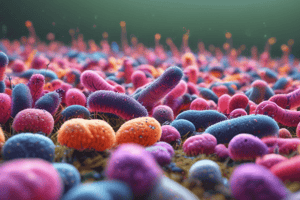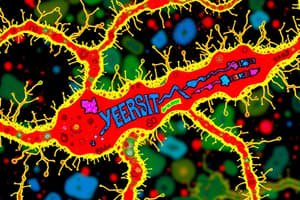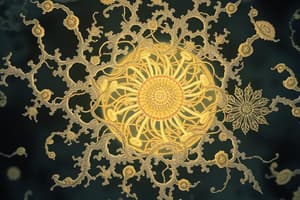Podcast
Questions and Answers
Which serogroups of Neisseria meningitidis are considered most important?
Which serogroups of Neisseria meningitidis are considered most important?
- A, B, C, X, Y, W-135 (correct)
- A, B, C, W-135
- B, C, D, Y, W-135
- C, D, E, F, G
What are the initial symptoms of meningococcal meningitis?
What are the initial symptoms of meningococcal meningitis?
- High fever and purpura
- Rash and respiratory distress
- Severe headache and coma
- Mild pharyngitis, fever, vomiting, headache, stiff neck (correct)
What is the hallmark symptom of meningococcemia?
What is the hallmark symptom of meningococcemia?
- Vomiting
- Petechial eruption (correct)
- Purulent exudate
- Severe headache
What complication is most commonly associated with meningococcemia?
What complication is most commonly associated with meningococcemia?
In which age group is meningococcal meningitis most prevalent?
In which age group is meningococcal meningitis most prevalent?
What is the primary entry portal for Neisseria meningitidis in humans?
What is the primary entry portal for Neisseria meningitidis in humans?
Which of the following is a characteristic of meningococci compared to gonococci?
Which of the following is a characteristic of meningococci compared to gonococci?
The presence of which type of rash is a telltale symptom of meningococcal disease?
The presence of which type of rash is a telltale symptom of meningococcal disease?
What characteristic differentiates Yersinia enterocolitica regarding temperature?
What characteristic differentiates Yersinia enterocolitica regarding temperature?
Which test is used for the culture of Yersinia enterocolitica?
Which test is used for the culture of Yersinia enterocolitica?
What is a Gram-negative characteristic of Neisseria gonorrhoeae?
What is a Gram-negative characteristic of Neisseria gonorrhoeae?
Which of the following symptoms is NOT typically associated with Yersinia enterocolitica infection?
Which of the following symptoms is NOT typically associated with Yersinia enterocolitica infection?
Which treatment option is known to be ineffective against Yersinia enterocolitica?
Which treatment option is known to be ineffective against Yersinia enterocolitica?
What role does urease play in identifying Yersinia enterocolitica?
What role does urease play in identifying Yersinia enterocolitica?
Which Neisseria species ferments lactose?
Which Neisseria species ferments lactose?
What clinical condition may develop in some patients infected by Yersinia enterocolitica due to immunologic reactions?
What clinical condition may develop in some patients infected by Yersinia enterocolitica due to immunologic reactions?
What is the primary virulence factor for Neisseria gonorrhoeae observed in piliated strains?
What is the primary virulence factor for Neisseria gonorrhoeae observed in piliated strains?
Which symptom is commonly associated with male gonococcal urethritis?
Which symptom is commonly associated with male gonococcal urethritis?
What is the treatment of choice for uncomplicated genital or rectal infections caused by Neisseria gonorrhoeae?
What is the treatment of choice for uncomplicated genital or rectal infections caused by Neisseria gonorrhoeae?
In which situation would doxycycline be contraindicated?
In which situation would doxycycline be contraindicated?
What type of infection is characterized by hemorrhagic papules and pustules in patients with gonococcal bacteremia?
What type of infection is characterized by hemorrhagic papules and pustules in patients with gonococcal bacteremia?
What is the most common presentation of Pasteurella infection after an animal bite?
What is the most common presentation of Pasteurella infection after an animal bite?
What laboratory characteristic distinguishes Pasteurella species?
What laboratory characteristic distinguishes Pasteurella species?
What is the primary drug of choice (DOC) for treating Pasteurella infections?
What is the primary drug of choice (DOC) for treating Pasteurella infections?
What is the most common organism found in human wounds caused by animal bites?
What is the most common organism found in human wounds caused by animal bites?
Which anaerobic bacterium is known to be part of the normal flora of the respiratory tract and gut of mice and rats?
Which anaerobic bacterium is known to be part of the normal flora of the respiratory tract and gut of mice and rats?
Which common clinical signs are indicative of anaerobic infections?
Which common clinical signs are indicative of anaerobic infections?
In which anatomical site is Peptoniphilus predominantly found?
In which anatomical site is Peptoniphilus predominantly found?
What is a typical cause of pneumonia or sepsis associated with P.pneumotropica?
What is a typical cause of pneumonia or sepsis associated with P.pneumotropica?
Which anaerobic infections are commonly associated with Bacteroides fragilis?
Which anaerobic infections are commonly associated with Bacteroides fragilis?
Which variable is NOT a characteristic of Gram-negative bacilli such as Bacteroides?
Which variable is NOT a characteristic of Gram-negative bacilli such as Bacteroides?
What type of infections are associated with the presence of mixed anaerobic flora?
What type of infections are associated with the presence of mixed anaerobic flora?
Which bacteria are commonly implicated in intra-abdominal infections?
Which bacteria are commonly implicated in intra-abdominal infections?
Which organism is primarily associated with infections of the female genital tract?
Which organism is primarily associated with infections of the female genital tract?
What is the drug of choice (DOC) for infections caused by Actinomyces species?
What is the drug of choice (DOC) for infections caused by Actinomyces species?
Which Gram-negative bacilli are most often responsible for human infections?
Which Gram-negative bacilli are most often responsible for human infections?
Which organism is recognized as part of the normal oral flora and is frequently isolated from gingival infections?
Which organism is recognized as part of the normal oral flora and is frequently isolated from gingival infections?
Which species of Clostridium is known for causing tetanus?
Which species of Clostridium is known for causing tetanus?
Which opportunistic pathogen is associated with acne vulgaris?
Which opportunistic pathogen is associated with acne vulgaris?
Which bacteria are characteristic of chronic infections producing pyogenic lesions with sinus tracts?
Which bacteria are characteristic of chronic infections producing pyogenic lesions with sinus tracts?
Flashcards
Yersinia enterocolitica characteristics
Yersinia enterocolitica characteristics
Yersinia enterocolitica is a gram-negative, non-lactose fermenting bacterium. It's urease-positive, oxidase-negative, and grows best at 25°C, becoming non-motile at 37°C. Transmission is common from eating raw or undercooked pork.
Yersinia enterocolitica pathogenesis
Yersinia enterocolitica pathogenesis
Yersinia enterocolitica infections typically incubate for 4-7 days, affecting the ileum. Initial symptoms include fever, abdominal pain, and diarrhea. In some cases, immune response can lead to arthralgia, arthritis, and erythema nodosum.
Yersinia diagnostic test
Yersinia diagnostic test
Diagnosing Yersinia involves using the cefsulodin-irgasan-novobiocin (CIN) agar. It's often self-limited; antibiotics include aminoglycosides, chloramphenicol, tetracyclines, and more.
Neisseria characteristics
Neisseria characteristics
Signup and view all the flashcards
Neisseria gonorrhoeae glucose test
Neisseria gonorrhoeae glucose test
Signup and view all the flashcards
Neisseria gonorrhoeae Modified Thayer-Martin medium
Neisseria gonorrhoeae Modified Thayer-Martin medium
Signup and view all the flashcards
Neisseria gonorrhoeae colony characteristics
Neisseria gonorrhoeae colony characteristics
Signup and view all the flashcards
Specimen collection for Neisseria
Specimen collection for Neisseria
Signup and view all the flashcards
Neisseria meningitidis serogroups
Neisseria meningitidis serogroups
Signup and view all the flashcards
Meningococcal Gram type
Meningococcal Gram type
Signup and view all the flashcards
Meningococcal shape
Meningococcal shape
Signup and view all the flashcards
Meningococcal meningitis symptoms
Meningococcal meningitis symptoms
Signup and view all the flashcards
Meningococcal disease manifestations
Meningococcal disease manifestations
Signup and view all the flashcards
Meningococcal portal of entry
Meningococcal portal of entry
Signup and view all the flashcards
Waterhouse-Friderichsen syndrome
Waterhouse-Friderichsen syndrome
Signup and view all the flashcards
Neisseria meningitidis carbohydrate utilization
Neisseria meningitidis carbohydrate utilization
Signup and view all the flashcards
Neisseria gonorrhoeae pili function
Neisseria gonorrhoeae pili function
Signup and view all the flashcards
Gonorrhea Pathogenesis
Gonorrhea Pathogenesis
Signup and view all the flashcards
Male Gonorrhea Symptoms
Male Gonorrhea Symptoms
Signup and view all the flashcards
Female Gonorrhea Symptoms
Female Gonorrhea Symptoms
Signup and view all the flashcards
Disseminated Gonorrhea
Disseminated Gonorrhea
Signup and view all the flashcards
Gonorrhea Treatment (Uncomplicated)
Gonorrhea Treatment (Uncomplicated)
Signup and view all the flashcards
Gonorrhea and Chlamydia Treatment
Gonorrhea and Chlamydia Treatment
Signup and view all the flashcards
Pasteurella presentation
Pasteurella presentation
Signup and view all the flashcards
Anaerobic bacteria
Anaerobic bacteria
Signup and view all the flashcards
Bacteroides fragilis group
Bacteroides fragilis group
Signup and view all the flashcards
Prevotella melaninogenica
Prevotella melaninogenica
Signup and view all the flashcards
Foul-smelling discharge
Foul-smelling discharge
Signup and view all the flashcards
Diagnosis of anaerobic infections
Diagnosis of anaerobic infections
Signup and view all the flashcards
Gram-negative anaerobes
Gram-negative anaerobes
Signup and view all the flashcards
Anaerobic infection sites
Anaerobic infection sites
Signup and view all the flashcards
Bacteroides
Bacteroides
Signup and view all the flashcards
Normal Bowel Flora
Normal Bowel Flora
Signup and view all the flashcards
Prevotella species
Prevotella species
Signup and view all the flashcards
Porphyromonas
Porphyromonas
Signup and view all the flashcards
Fusobacterium
Fusobacterium
Signup and view all the flashcards
Veillonella
Veillonella
Signup and view all the flashcards
Actinomyces species
Actinomyces species
Signup and view all the flashcards
Clostridium tetani
Clostridium tetani
Signup and view all the flashcards
Peptostreptococcus
Peptostreptococcus
Signup and view all the flashcards
Study Notes
Yersinia
- Gram(-), short, pleomorphic, non-motile
- Bipolar staining
- Catalase +
- Oxidase -
- Microaerophilic/facultative anaerobe
Yersinia enterocolitica
- Non-lactose fermenter
- G(-)
- Urease +
- Oxidase -
- Grows best at 25°C
- Motile at 25°C, non-motile at 37°C
- Transmission: eating raw or undercooked pork
Pathogenesis and Clinical Findings
- Incubation: 4-7 days
- Early symptoms: fever, abdominal pain, diarrhea
- One to two weeks after onset, some patients develop arthralgia, arthritis, and erythema nodosum, suggesting an immunologic reaction to the infection
Diagnostic Laboratory Tests
- Culture: cefsulodin-irgasan-novobiocin (CIN) agar
- Treatment: self-limited
- Susceptible to: aminoglycosides, chloramphenicol, tetracycline, TMP-SMX, piperacillin, third-generation cephalosporins, and fluoroquinolones
- Resistant to: ampicillin and first-generation cephalosporins
Neisseriae
- Gram(-), nonmotile diplococcus
- Aerobic, acid-producing
- Oxidase +
Neisseria Gonorrhoeae
- Table 20-1 details biochemical reactions (details in table)
Diagnostic Laboratory Tests (Neisseria)
- Specimens: Pus, secretions from urethra, cervix, rectum, conjunctiva, throat, or synovial fluid for culture and smear
- Culture: Modified Thayer-Martin medium (MTM), incubated in 5% CO2 at 37°C
- Transparent or opaque, nonpigmented, and nonhemolytic colonies
- N. flavescens, N. cinerea, N. subflava, and N. lactamica (yellow pigmentation)
- N. sicca: opaque, brittle, wrinkled colonies
- M. catarrhalis: nonpigmented or pinkish gray opaque colonies
- NAAT, ELISA
Neisseria meningitidis
- Most important serogroups: A, B, C, X, Y, and W-135
- Gram(-)
- Oxidase +
- Kidney-shaped diplococcus with a polysaccharide capsule
- Ability to use both glucose and maltose
Neisseria meningitidis: Disease
- Meningococcal meningitis
- Most prevalent in children 6 months to 2 years
- Begins as mild pharyngitis
- Fever, vomiting, headache, and stiff neck
- Pneumonia may be present
- Petechial eruption, progressing to frank purpura
- Vasculitic purpura is the hallmark
Pathogenesis, Pathology, Clinical Findings (Meningitis)
- Humans are the only natural hosts
- Nasopharynx is the portal of entry
- Early symptoms may resemble upper RTI
- Fulminant meningococcemia: severe, high fever, hemorrhagic rash; possible DIC and circulatory collapse (Waterhouse-Friderichsen syndrome)
- Meningitis: most common complication, sudden onset with intense headache, vomiting, stiff neck, progresses to coma within hours
- Acutely inflamed meninges, thrombosis of blood vessels, exudation of PMNs, thick purulent exudate on brain surface
- Meningococcemia: thrombosis in many small blood vessels across organs; perivascular infiltration; petechial hemorrhages, interstitial myocarditis, arthritis, and skin lesions
Meningococcal Disease
- Two most common manifestations: meningococcemia (blood infection), meningitis (spinal cord/brain infection)
- Bacteria enter through nose and throat; spreads to bloodstream; then enters spinal cord and brain membranes
Neisseria spp.: Carbohydrate Utilization test
- Table showing glucose, maltose, and lactose results for N. gonorrhoeae and N. meningitidis
Neisseria gonorrhoeae: Antigenic Structure
- Pili (fimbriae): hair-like appendages, enhance attachment to host cells and resistance to phagocytosis
- Por: prevents phagosome-lysosome fusion; selectively binds to complement components C3b and C4b
- OPA proteins: adhesion within colonies and attachment to host receptors
- RMP (Protein III): resistance to killing by human antibody-complement; interferes with gonococcal binding to phagocytic receptors
- Lipooligosaccharide: resistance to killing by human antibody-complement and interferes with gonococcal binding to phagocytic receptors
Pathogenesis (Neisseria gonorrhoeae)
- Only piliated bacteria are virulent
- Opaque colonies: men with symptomatic urethritis, uterine cervical cultures at mid-cycle
- Transparent colonies: men with asymptomatic urethral infection, menstruating women, invasive forms like salpingitis, disseminated infection
Pathology (Neisseria gonorrhoeae)
- Gonococci attack mucous membranes of the genitourinary tract, eye, rectum, and throat → acute suppuration → tissue invasion → chronic inflammation and fibrosis
Clinical Findings (Neisseria gonorrhoeae)
- Males: urethritis, yellow creamy pus, painful urination, extends to epididymis, fibrosis can occur, urethral strictures
- Females: endocervix infection, urethra and vagina; mucopurulent discharge; salpingitis; fibrosis; obliteration of tubes
- Gonococcal bacteremia: skin lesions (hemorrhagic papules and pustules), tenosynovitis, and suppurative arthritis (knees, ankles, and wrists)
- Gonococcal ophthalmia neonatorum: during passage through an infected birth canal
Treatment (Neisseria gonorrhoeae)
- Uncomplicated genital or rectal infections: Ceftriaxone 1 g IM as a single dose
- Concomitant chlamydial infection: Azithromycin 1 g orally in a single dose or with doxycycline 100 mg orally twice a day for 7 days
- Azithromycin is safe for pregnant women, with doxycycline contraindicated.
Pasteurella
- Non-motile gram(-) coccobacilli
- Bipolar staining
- Aerobes or facultative anaerobes
- Oxidase and Catalase +
Pasteurella Presentation
- Most common presentation: history of animal bite, within hours: redness, swelling, and pain
- Regional lymphadenopathy may be variable
- Fever often low-grade
- Penicillin G - DOC
- Tetracyclines and fluoroquinolones - alternative
Pasteurella Species
- P. multocida: most common in human wounds from cat and dog bites; common cause of hemorrhagic septicemia in animals
- P. bettyae: infections of human genital tract and newborns
- P. pneumotropica: normal flora of mice and rats; causes pneumonia or sepsis when host-parasite balance is disturbed
- P. ureae: mixed flora in human chronic respiratory disease or other suppurative infections.
Anaerobic Bacteria
- Located throughout the human body: skin, mucosal surfaces, high concentrations in the mouth and GI tract (normal microbiota)
Diagnosis of Anaerobic Infections
- Clinical signs: foul-smelling discharge (caused by short-chain fatty-acid products of anaerobic metabolism), proximity to a mucosal surface (anaerobes are part of normal microbiota), gas in tissues (production of CO2 and H2), negative aerobic culture results
Gram-Negative Anaerobes: Bacilli
- Bacteroides: bile-resistant, non-spore forming, slender gram-(-) rods; may appear as coccobacilli; normal bowel flora; often implicated in intra-abdominal infections (e.g., B. fragilis, B. thetaiotaomicron)
- Prevotella: gram-(-) bacilli; may appear as slender rods or coccobacilli; P. melaninogenica (upper respiratory tract infections); P. bivia and P. disiens (female genital tract); brain and lung abscesses, empyema, PID, and TOA
- Porphyromonas: normal oral flora; cultured from gingival and periapical tooth infections; common in breast, axillary, perianal, and male genital infections
- Fusobacteria: most human infections are caused by F. necrophorum and F. nucleatum; F. necrophorum cause severe infections of the head and neck; can progress to Lemierre's disease
- Veillonella: small, anaerobic, gram-(-) cocci; normal flora in the mouth, nasopharynx, and probably the intestine; rarely the sole cause of an infection.
Gram-Positive Bacilli
- Actinomyces: A. israelii and A. gerencseriae are common types; encountered in groin, urogenital areas, breast, axilla, and postoperative mandible, eye, head, and neck infections; chronic suppurative and granulomatous infections produce pyogenic lesions, with interconnecting sinus tracts containing microcolonies of the bacteria embedded in tissue elements; DOC: Penicillin
- Lactobacillus: normal flora of the vagina, rarely cause disease
- Propionibacterium: normal flora of the skin, oral cavity, large intestine, conjunctiva, and external ear canal; opportunistic pathogen; acne vulgaris; cause postsurgical wound infections (prosthetic joint infections, CNS shunt infections, osteomyelitis, endocarditis, and endophthalmitis)
- Eubacterium, Eggerthella, Bifidobacterium, and Arachnia: occur in mixed infections of the oropharyngeal or bowel flora
- Clostridium tetani: ubiquitous; >50% of cases follow minor injuries; tetanospasmin, a potent neurotoxin; preventable with active immunity induced by tetanus toxoid
Gram-Positive Cocci
- Peptostreptococcus: opportunistic; in brain abscesses, pleuropulmonary infections, necrotizing fasciitis, other deep skin and soft tissue infections, intra-abdominal infections and female genital tract infections.
Gram-Positive Bacilli
- Clostridium botulinum: preserved or canned foods, low oxygen levels and low pH, which support growth, neurotoxins as most potent toxins, can be neutralized by specific antibodies
- Clostridium perfringens: causes gas gangrene and food poisoning; produces alpha toxin (necrotizing, hemolytic exotoxin that is a lecithinase)
- Clostridium difficile: causes pseudomembranous colitis, part of the normal GI flora in 2-10% of humans, from diarrhea alone, to marked diarrhea and necrosis of mucosa.
Studying That Suits You
Use AI to generate personalized quizzes and flashcards to suit your learning preferences.




